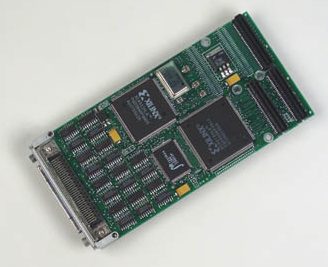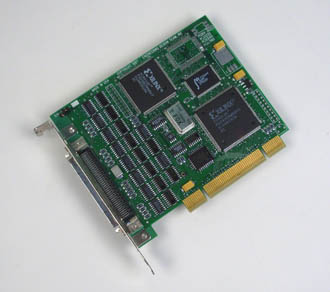LVDS / RS-422 frame grabber for PMC
This product has been discontinued, and is no longer supported. The information on this page is provided for reference only.
Features
- Single PMC slot
- Interfaces RS422 or LVDS digital CCD cameras to PMC/PCI computers
- 68-pin AMP connector
- Supports up to 24 bits of camera data
- Direct memory access to host memory — camera resolution independent
- PMC/PCI 33 MHz 32 bit Local Bus data rates up to 100 MBytes/sec as supported by host
- Supports AIA serial command interface over RS422 or LVDS signal pairs, cable adaptor for RS232 signal levels available
- Device drivers for Linux, Windows and MacOS are included with the board (Others may be available on request — contact us for details.)
- PCI Bus (PCI DVK) version also available
Description
The PMC DVK provides high-resolution image capture for AIA Monochrome, Category 1, extended single and dual channel digital cameras. Spatial and depth resolution and the number of buffers are limited only by the host memory. Images can be captured and displayed in real-time. The PMC DVK is similar to the PCI DVK, except that it fits the PMC form factor. s
Applications
- Machine vision
- Manufacturing/Inspection
- Computer microscopy
- Astronomy
- Aerial mapping
- Image archiving
- Image processing and analysis
- Medical imaging
- Multimedia
- Security
Cameras Supported
The PMC DVK’s 68-pin connector makes it ideal for cameras with standard 68-pin SCSI II type cables/connectors, such as the Redlake MEGAPLUS i and ES models. Cables are also available for the Texas Instruments TMC-1001PF, Raytheon Infrared Radiance 1 and HSX, Cincinnati Electronics Irris 256 ST, Dalsa 4M4, 1M30P and BT25, and most Hamamatsu cameras. Most AIA monochrome and color, Category 1, extended single and dual channel digital cameras are also supportable, but may require a custom cable. See Cables for more information.
Software
The PMC DVK comes with a configurable device driver, a C language interface library, example programs, and an X-Windows or MS Windows based camera control and image capture and display program (click here for screen shots). The device driver provides direct virtual memory access for the host computer, including features for controlling the device and determining its status. Example programs demonstrate this capability using the functions provided in the library. A number of Third Party products are available as well to provide turn-key solutions to image acquisition needs.
>Specifications
A programmable gate array is configured for a specific camera when the driver is loaded. Thirty-two RS422 or LVDS signals are configured as inputs or outputs, as required by the camera. Outputs can also be configured as single-ended for TTL camera control lines. The PMC DVK does not include frame buffer memory. Video data is stored in host memory as required by the camera and application.
Device drivers for Linux, Windows and MacOS included.
The PMC DVK can be used with Redlake MASD’s (formerly Kodak) 68-pin to 68-pin RS422 AIA cable, part #03000172-001. Be sure to specify this cable when ordering the camera from Redlake. Redlake’s RS-232 breakout cable (part #03000173-001) can be used, but is not recommended since it diverts the RS-232 signals to the COM port, and serial commands needed for set-up and control will need to be done manually through a terminal program or other COM port based tools.
Most other category 1, extended single and dual channel digital cameras are also supportable. Contact EDT for information on what cables are available for other cameras.
Single PMC slot
Dimensions: 74mm x 152mm
Weight: 2.8 oz.
AMP high density 68 pin connector*
*Manufactured by AMP Inc. 1-800-522-6752
Operating: 10° to 40° C
Nonoperating: -20° to 60° C
(Optionally -40° to +85° C operating — contact EDT for details)
Heat Output: 5 W
Operating: 20% to 80% noncondensing @ 40° C
Nonoperating: 95% noncondensing @ 40° C
>System Requirements
Note: This outlines the minimum recommended requirements for a typical application that uses EDT interface boards. In practice, few situations are ‘typical’. We urge you to read this for a broader discussion on making sure your system is adequate for the task of accepting high speed DMA data with an EDT interface board.
Intel
Processor: Pentium III or IV/400Mhz+, or AMD Athalon
Memory: 512 Mb minimum
Cache memory: 256 Kb.
PCI Bus: Adequate bandwidth for camera in use. click here for detailed information on bandwidth requirements
Video: AGP Display (IMPORTANT: Use of PCI Video boards on the same bus as an EDT I/O board is NOT recommended)
OS: Linux, Windows, MacOS
Patches: Windows NT service pack 6, Windows 2000 service pack 1
>Support
EDT provides several levels of customer support, from phone consultations to custom design of hardware or software at hourly rates. Technical support is also provided though the Technical Information section of this web site.
>Ordering
To order, contact our sales department or your distributor. Be sure to specify which cable will be needed (if any). It is usually helpful to know which camera is being interfaced to as well.
All Trademarks referenced are the service mark, trademark, or registered trademark of the respective manufacture


